How to prepare your lawn for fall in Canada
Maintain your lawn this fall to ensure greener, healthier grass next spring
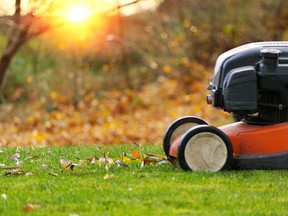
Article content
Reviews and recommendations are unbiased and products are independently selected. Postmedia may earn an affiliate commission from purchases made through links on this page.
With summer winding down in Canada, it’s time to turn our attention to preparing our homes and gardens for the cooler weather. Lawn care, and grass in particular, is a top priority as the weather cools – especially if you’re looking to get a jump on lawn care for the following year’s growing season.
“Fall is a great season for getting outside with the more moderate temperatures and changing foliage, but it’s also the time of year to prepare trees, shrubs, grass and gardens to better weather the colder months,” says Kris Kiser, president and CEO of OPEI, an international trade association representing manufacturers and suppliers of outdoor power equipment.
“What you do now will set the tone for what your yard will look like and how healthy it will be next spring.”
Fall lawn care is especially important because it’s when grass plants actively store nutrients and energy for the winter months ahead. Proper care helps strengthen root systems, improve disease resistance, and prepare your lawn for a strong spring start.
To help ensure the health of your lawn come next spring, you’ll want to follow these lawn care tips.
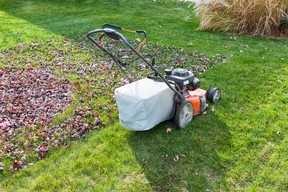
How to prepare your lawn for fall
Continue mowing the grass
As long as your grass is growing, it’s safe to keep mowing your lawn this fall. Luckily, growth slows as the weather cools, so you likely won’t be mowing as frequently as during the summer months. However, it’s still important to keep an eye on growth and maintain a mowing schedule until winter hits.
Cool-season grasses often continue to grow into late October and November. It’s recommended to continue regular lawn maintenance until you perform your final mowing of the season, about a week before the first frost.
Maintain the length of your grass at 2.5–3 inches throughout the fall. This length provides enough leaf surface for effective photosynthesis while preventing grass from matting under snow. Note that cutting grass too short can affect the root system, weakening the lawn’s ability to withstand winter weather.
Tools you’ll need:
- A lawn mower – Consider manual mowers for small lawns, and electric or gas-powered lawn mowers for larger yards.
- Edge trimmers – Keep your lawn’s edges neat and tidy.
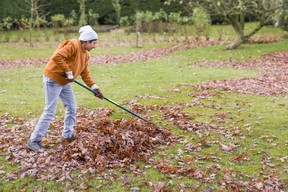
Rake and mulch leaves
Raking your lawn throughout the autumn season prevents fallen leaves from blocking sunlight and trapping moisture, which can suffocate the grass underneath. Whether you opt to mulch or bag the fallen leaves, it’s important to expose your lawn to sunlight, air and water to promote growth.
Shredding leaves into tiny pieces by mulching them has benefits that raking and bagging don’t. Mulching helps keep yard waste out of the local landfill and adds organic matter back into the soil.
Tools you’ll need:
- A rake – If you choose to remove the fallen leaves, you can rake them up and dispose of them with compostable yard bags.
- A leaf blower – If raking the lawn sounds like too much of a chore, a leaf blower is a faster way to collect fallen leaves.
- A lawn mower or mulcher – Shredding up fallen leaves turns them into mulch and that breaks down quicker than whole leaves.
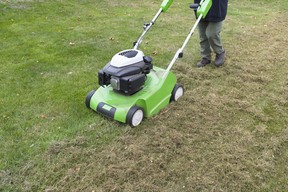
Dethatch for healthier lawns
While we’re all familiar with mowing and raking the lawn, dethatching may not be as commonly understood. The process involves removing the thick layer of thatch — the layer of dead grass, roots and other organic material — that accumulates between the soil and your lawn.
When the thatch gets too thick, it can prevent air, nutrients, sunlight and water from reaching your lawn’s soil and roots. Early fall is the ideal time to dethatch your lawn as it helps improve airflow and nutrient uptake while strengthening the grass’ root system.
Tools you’ll need:
- A dethatcher – You can use either a manual dethatcher, a power rake or an electric dethatcher to break up the thatch.
- A rake – Once the dethatching is complete, you’ll want to rake up and compost the debris.
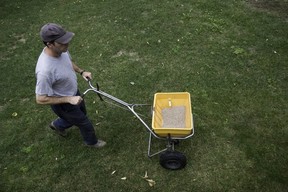
Finish with aerating, seeding and fertilizing
The entire dethatching process can stress your lawn. Don’t forget to follow it up with a round of aerating, fertilization and overseeding to ensure a healthy lawn the following growing season.
Tools you’ll need:
- An aerator – Aerating your lawn can reduce soil compaction, improve soil structure and ensure correct airflow to grass roots.
- Grass seeds – Overseed (add additional grass seeds to an already-growing lawn) and sow seeds on open soil to repair bare patches.
- Fertilizer – Give your lawn a boost of nutrients before the cooler weather arrives. Fertilizing in the call can help existing grass recover and encourage new grass growth.
Shopping Essentials, a category written by research-obsessed shopping fanatics, is now on Canoe.com. Explore in-depth product reviews, expert recommendations and exciting collaborations — plus get behind-the-scenes info on your favourite brands and trending products — learn more here or sign up for our newsletter.












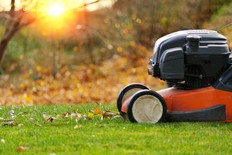

Postmedia is committed to maintaining a lively but civil forum for discussion. Please keep comments relevant and respectful. Comments may take up to an hour to appear on the site. You will receive an email if there is a reply to your comment, an update to a thread you follow or if a user you follow comments. Visit our Community Guidelines for more information.